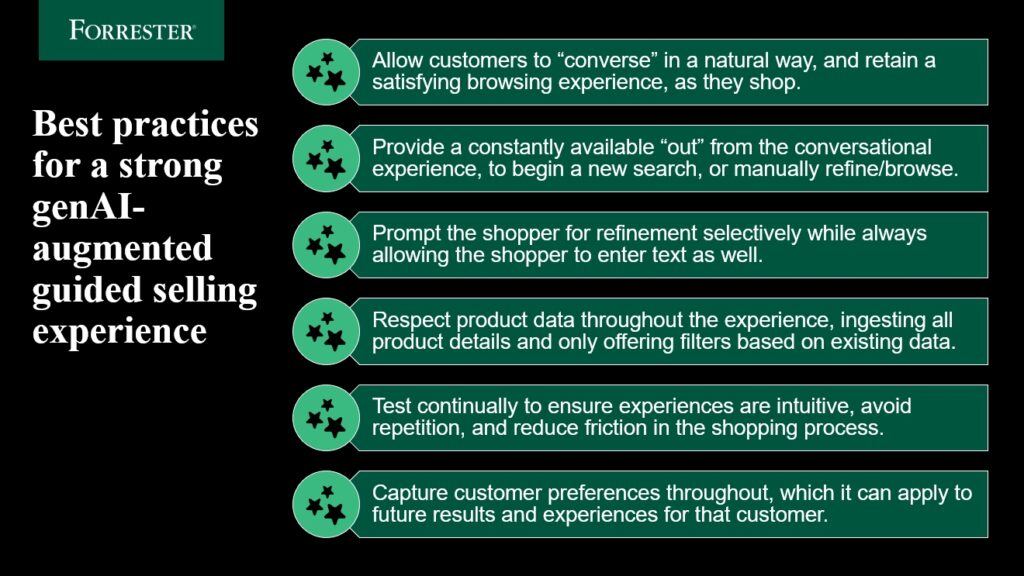Agentic Commerce? Conversational Commerce? The Future Of Owned Digital Shopping Experiences
Current (early) genAI shopping assistants don’t create great experiences.
The future isn’t just conversational or agentic commerce; it is genAI-augmented guided selling.
You know what no consumer ever said they want? A single, generic shopping experience that resembles a customer service chatbot.
I contend that guided selling experiences, augmented by generative AI, are the future of digital shopping in owned environments (on a website or app that the brand/retailer controls).
I’ve heard a lot of people echoing the sentiment, “But ChatGPT and Perplexity are going to train people to use chat interfaces to shop.”
Yes, answer engines likely will change some customer behaviors to some degree. Search queries are becoming more conversational. Consumers are asking questions rather than entering search terms. They are using natural language and nuance, learning to refine further rather than start over. Agentic commerce will become “a (significant) thing” in the near future.
No, the retail website will not just go away.
But those non-owned experiences in answer engines won’t completely define the future of shopping on brands’ and retailers’ owned experiences.
To start, they’re not as widely used yet as some sources might suggest. To date, 24% of US online adults have used ChatGPT, per Forrester’s Consumer Benchmark Survey, 2025. Another 20% say they plan to use it this year. Those numbers are lower for other answer engines (e.g., Gemini), and they’re consistent with the data for UK online adults. They increase a bit for just Gen Z alone (33% vs. 24%), but it’s still not nearly a majority who have tried it, let alone who use it regularly.
These shifts still don’t mean that shopping will be relegated to the chat bubble.
Current Chat-Based GenAI Shopping Experiences Are A Work In Progress
In the most recent Forrester Wave™ for commerce search and product discovery solutions, nearly half of the vendors received the highest score for their agentic/conversational selling tools. Those vendors all provided live examples of their customers using these genAI shopping assistants on their websites.
That said, based on my own testing of these experiences, they are immature. Technically, they’re still more assistive than agentic because they aid customers in finding products but don’t do much (if anything) autonomously. For end customers, they create negative experiences at worst and vaguely helpful experiences that generate some friction at best. I found that conversations are unintuitive, the scope of the bot may be unclear, and results are sometimes completely nonsensical.
Historically, Guided Selling Offered An Interactive But Predetermined Experience
Guided selling itself isn’t new. For example, it’s been used on:
- Beauty websites to sell skincare products. The shopper takes a quiz and provides their age, skin traits, concerns, and preferences. The system then displays products that are best suited to the shopper.
- Car parts websites to sell parts. The shopper provides the year, make, and model of their vehicle so the site only displays compatible parts.
But these processes only prefiltered the results, meaning if you’ve already selected the year, make, and model of your vehicle, the results preselect the appropriate filters to target the results. It was prebuilt logic.
Sometimes, the experience included more interactive, interspersing guided steps (such as buttons for common filters) with product sets. Imagine the skincare example, but each selection is followed by product listings and the option to further refine (e.g., based on skin type or concerns), rather than a one-and-done quiz.
Of course, all of this was possible before genAI. These guided selling experiences just expose filters based on product attributes, or preset groups of products, into a more natural buying experience. They don’t adjust based on the customer’s behavior, and they lengthen the selling funnel, sometimes forcing customers through steps before they could review product listings.
GenAI Enables Huge Experience Improvements — Or Massive Experience Deterioration
With generative interfaces, we have the chance to add depth and discussion to this process. As Sana Remekie, CEO and co-founder of Conscia (an agent-ready experience orchestration engine), explains, “The future of guided selling will be a hybrid of traditional browse/search interfaces and a chat-based shopping assistant.” I tend to agree. The problem with expecting that current search experiences will be completely replaced by agentic chats is that it assumes shoppers don’t actually want to shop.
In fairness, sometimes this is true. If all you need is a box of toothpicks, you probably won’t want to browse aisles and narrow down the options. But a browsing experience is still fun, preferred, or necessary for high-consideration items such as specialty products, apparel, and electronics.
GenAI-augmented guided selling doesn’t mean slapping a chat bubble into a site as a catch-all for generative shopping experiences. This would be a deep deterioration of the experience in many cases. Instead, consumers will interact with a visual guide (showing an increasingly refined set of products with a next-best-step interface) integrated with a natural-language experience.
What Would The Ideal GenAI-Augmented Guided Selling Process Look Like?
Maybe you’re shopping for a new backpack, so you just type the word “backpack” into the search box, which is the same box as where you’d enter a conversational prompt.
- The genAI agent might reply “Tell me more about how you’ll use it” in a conversational prompt.
- Please imagine that the prompt is the search box or at the top of the product listing, not relegated to a chat bubble.
- If there are suggested filters or answers (such as “travel backpacks” or “work backpacks”), they’re relevant and tied to the product data and likely next step.
- Of course, the questions are related to the product attributes, aimed at further refining the results.
- Ideally, there is also an easy “out” for the user at every step. They’re not stuck in a logic puzzle and can immediately see product listings on the same page as the chat.
- If a user answers something like “everyday pack but also for travel,” the product results on the page would instantly update to remove anything too bulky or sporty, focusing instead on daypacks that meet carry-on requirements.
- The genAI agent might briefly explain that decision and ask another question, such as “What electronic devices will you carry with you?” to see whether a laptop pocket will suffice or whether the customer needs additional, soft-lined pockets for tablets or gaming consoles.
- At every step, there are options to continue the “conversation” to further refine or adjust the results, manually filter the results, browse and compare products, or start a new query.
Customers Will Not Want To Be Stuck In An Endlessly “Guided” Experience
At any point, the customer must have an easy off-ramp from the chatlike experience as the products appear and refine with each new input. The conversation persists on (but doesn’t dominate) the screen so that, at any point, it’s available for further refinement. Unlike search alone, adding a word like “black” won’t create a brand-new set of results but will refine the results by color.
An obviously unrelated term, or clear words such as “Find me a matching wallet,” will begin a new search. A traditional search box tucked away at the top of the page might enable the customer to start over, as well.
When it comes to checkout, familiar cart processes can kick in. But checking out via an agentic experience is easier to enable within owned brand experiences than in non-owned answer engines. The site/app likely already stores payment and shipping information for known customers. And unlike external answer engines like ChatGPT, Google Gemini, or Perplexity (currently), the site can authenticate the customer, save the order in the customer’s account, and provide any entitlements such as loyalty benefits.
GenAI-Augmented Guided Selling Can Change The Game — If It Provides Safeguards
These genAI-enhanced experiences need safeguards to avoid experience-killing traps like longer sales funnels, frustrating chat traps, and irrelevant answers.
Finally, remember these best practices to move beyond canned “conversational” experiences and limited chatbots.

Huge thanks to the additional Forrester analysts who contributed to this post, including Nikhil Lai and Lily Varon.
